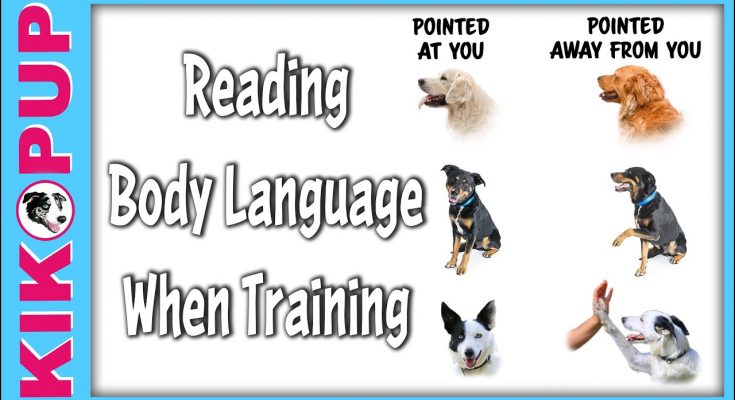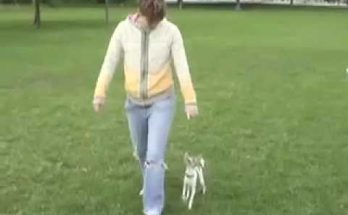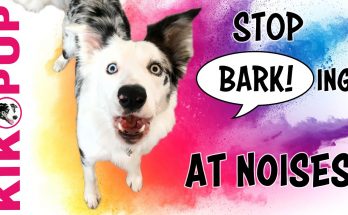How to read your dog’s body language in training sessions. Firstly we shall look at what the ears of the dog are telling us during a training session. When training a dog you want to shoot for the ear position on the left: POINTED AT YOU, relaxed or perky. I call these ears “expectant” they are expressing that the dog is expecting something to happen that he is not conflicted about. The ear positions on the right, POINTED AWAY FROM YOU give you information that your dog might be feeling somehow conflicted, uncomfortable or anxious.
Don’t panic if you see your dogs ears go back during training. Your dog is just communicating with you. When you see the ears go back, you can tweak your training plan by breaking the training up into smaller steps and trying to figure out what is making your dog feel uncomfortable so you can get those ears back up and looking perky or relaxed.
Your dog’s ears will also move around if he is listening to sounds in the environment. This is also information though, as when his ears are moving around, he will not be as focused on learning so don’t train a new behavior in a distracting environment until you have his full focus. Dogs also put their ears back in every day life when greeting dogs or people. This is normal dog behavior.
Want to become a trainer that is great at reading dogs? Film your training sessions, and when you watch back the footage, pay attention to just one part of your dog’s body during the whole session – his eyes, his mouth, his neck, feet, body posture or ears. To begin with, watch your dog’s ears. By watching back the footage you will see things you missed while training.
When a dog is directly in front of you during a training session, the dog’s gaze should ideally be POINTED AT YOU, the reinforcement or in the direction of the task. If you notice the dog’s gaze start to POINT AWAY FROM YOU or the task, this gives you vital information about what to do next in the training session.
Dogs can look away during training for many reasons. Some reasons include, that the dog is uncomfortable or stressed, that the reinforcement is not of high enough value, the session has gone on too long or that the dog is simply distracted by the surrounding environment. Regardless of the reasons, the dog is not paying 100% attention and is not 100% in the training game. When a dog starts to look away, you can reassess if something is causing the dog to feel uncomfortable. There could be some unintended social pressure you were unaware of, for example the dog could perhaps be feeling uncomfortable that you are leaning over him. If you believe this is not the case, you can see if using a higher value of reinforcement will get your dog back in the game. If this does not work, it’s not a good idea to train new behaviors without having your dog’s full attention. You can either give your dog a break or you can ask for behaviors that your dog knows and loves and use a higher rate of reinforcement. It is normal for dogs to be slightly distracted during training when working in new environments for the first time. So I suggest when you begin training somewhere new, warm up with attention games, your dog’s strongest behaviors or a settle.
In a training session with your dog in front of you take note of your dog’s body posture. The ideal picture is that your dog’s posture is relaxed in a neutral position or leaning toward you, the task or the reinforcement. When you see your dog’s neck and chest start to shift away from you, downward, to the side or back away from you or the task, this is giving you information. Imagine you are talking to someone and you see them leaning their chest and neck in your direction. They most likely feel comfortable with you and are engaged in what you have to say. Then you see them start to lean away from you… Something has changed. If they are just getting comfortable, that’s a different story. But if you see their center of their body start to point elsewhere… It is information. The same is true with dogs.
All dogs communicate differently with their body posture just like people. Also, outside of training sessions your dog might change his body posture according to different social scenarios. Your dog might have the tendency to greet you or other dogs with a submissive appeasing posture or lean away from another dog who is trying to lick him.
Just to note, I don’t condone having young kids hug dogs but used the picture for “leaning to the side” because it is a very good visual example of a dog feeling uncomfortable. You will also notice the facial expression is very telling.
#dogbehavior #dogtraining #understandingdogs





Filming my training sessions has been incredibly valuable. I can clearly see all the mistakes I’m making and enables me to refine training sessions to a great degree in terms of posture, position, reward placement and all that good stuff.
Great video. I’m learning so much.
I like this! Anytime anyone asks me to make a training video, I always refer them your way! I don’t want to spend the effort making it when there are already good ones out there! 🙂
Thats very sweet of you! 🙂
Great video ,love the tips ,so now I will watch my kids more closely, I mean my fur babies, lol.
Thanks for the different ways you offer information. I think you are the only one who is doing this. I really appreciate it. Very important topic too.
Thanks Ted 🙂
Thank you, Emily! Always helpful.
I love your advices, I’ve been following them for the last 10 years. Thanks for doing this.
Thanks for the comment on my video 🙂 That means a lot to me. Because it makes my videos get more views.
hanks for posting another wonderful tutorial.
Many don’t understand that dogs being highly social pack anamals have to have excellent communications systems in order for them to function.
Slightly off training topic but my point of complex dog body language.
My dog recently defused a situation with two male dominant dogs that she knew.
She approched & brushed up against one from the side and flicked her tail in his face whilst looking back at him head slightly tilted. This took just seconds & would go mostly unnoticed but her actions was deliberste, precise & its effect of defusing the situation was highly effective.
This requires a complex level of thinking, communication, sociability & understanding.
We have such beautiful animals.
If anybody has observations/experience of dogs body language they wouldn’t mind sharing, please post.
Thanks Emily for all what you do. Absolutely love your channel. You are wonderful.
Oh wow. I can just picture that. Some dogs seem better at communicating and understanding than other dogs. Some extremely talented. I guess like people. 🙂
@Dog Training by Kikopup
Dogs communicating is an area I find particularly interesting. I have watched & listened very closely for years but still understand so very little. I find this is such a fascinating & beautiful area of dog behaviour.
Thanks for your wonderful work, & finding the time in your busy schedule to reply to me.
Love your channel & what you do. Thank you so much.
WONDERFUL! THANK YOU! This is such good and important information! I am very excited to share this. I emailed a link to one of your most recent videos, the one that has many links in the description, to someone that needs help training. She says is using one already. If I had a dog I would be wearing out my computer watching your videos. Again, thank you so much for all you share. It is greatly appreciated. <3
Awe. And thanks for helping that person!
@Dog Training by Kikopup My help is VERY limited without friends like you and Pamela Johnson! I cannot thank you enough! <3
Perfect timing at 44 sec with Wish.
“Let’s look at the ear positions of the dog”
Again at 3.55 with “dogs can look away” was beautiful also.
Absolute perfection.
Thanks for posting
I tried to teach my Tervuren to spin just like I taught my Jack Russell, by using a lure above the dogs head and making them turn in a circle. When I did this in the beginning he understood it clearly, but all of a sudden, one day he stopped following the lure and just jumped up on me as soon as I moved my hand over his head. He was terrified… this made me suspicions as to what had changed, and I believe someone in my family has hit him at some point, maybe not intentionally, but he had definitively been traumatized by something.
He has gotten over it now fortunately! I’m just so worried about what made him scared in the first place…
Awesome video on postures. My trainer highly recommended you a few years ago when I first took puppy classes with my dog. I still watch your videos, and you’re the best.
Awe thanks!
Clear concise and really helpful.
Hi Emily! I’ve been watching your videos for a decade. Your new pup is adorable! Its great
to see Kiko, Tug and Splash hanging out in the background, wise older sages. I love senior doggos.
Im rewatching some now with
my 5 yr old hoarding rescue doughter, who is afraid of the world, basically.
My mantra when I comfort her fears in front of dog people who don’t get it;
“Emotions are not Behaviors” Thank You! Thank You!!
I have done the lip licking and sighing at the vet and it helps!!
She trusts me thinks it’s hilarious when I understand what she is asking for.
Sometimes I may ask her to try the dog playground once in a while, and she sits on my foot.
We did this the other day and she seemed interested in the action….
a very nice dog am sure came up directly to her face, in her face. Nose to nose. Ears back, maybe he was
OK I just thought f a person did that to me I would not stick around.
I scooped her up and took her out. Am sure the other humans thought I was coddling whatever.
I’m not in a relationship with them. When I adopted her we had not met, and she was so shell shocked I could not touch her.
She didn’t respond and I thought she may be not the smartest crayon if you know what I mean. Not true.
She had an ear infection.
She loves weaving, cop cop, high fives, boxes…
Recently she has had trouble deciding what to do at night. She paces and circles.
Can’t figure out where to settle.
So we tried your vid “ Go To Your Bed.” It was great. It relaxed her and made her happy.
Sometimes she thinks the clicker is the reward?! Same with targeting; she fetched and ate the post it:)
It’s her past life of recycling…
Thanks so much for all your hard work. Wish I lived in SD:)
You sound like an amazing trainer, not many people would think to reinforce going to a bed to fix the pacing or take the time to do it. Well done on all your hard work! And that is hilarious about the post it!!!!
Wow, you’re the best! Thank you for responding!
I have to look at your website for help with some issues.
(Big Hallway Vaccum@#&**!!)
Best to you and the Pups!
The puppy will keep the seniors young/
10 is the new 5!
Thank you! So helpful. A question… submissive grinning. Is it ok? Does it mean puppy is nervous? How to address that? Our puppy is doing a lot of submissive grinning, every morning and whenever he hasn’t seen you for awhile he will do it again.. anyone have video about this?
Oh thank you so much!! I always love the way you describe things. As a trainer-in-training, this is the area I feel a bit overwhelmed by and yet it’s the most important one! 😳
Yes please make more videos on bodylanguage! 😄
https://www.youtube.com/watch?v=xZbeFrr9hyg This is a video on dog play where I hosted another trainer
thanks for a great vid and solid advice.. appreciate that you share your knowledge so freely.. regards from Brisbane Australia 👋🇦🇺🦘🐕🦺🇦🇺
excellent point and topics however I think showing video footage of ~ 3 different dogs doing each behavior would really help a lot of people. I find many people miss read dog body language though understand every description and still pictures about it.
you do have examples in other videos as do other trainers but I would totally watch 30 min – 1 hr long presentation over this kinda stuff.
Such helpful tips, always right to explaining the point and then to illustration and examples, all without intros and outros and sales.